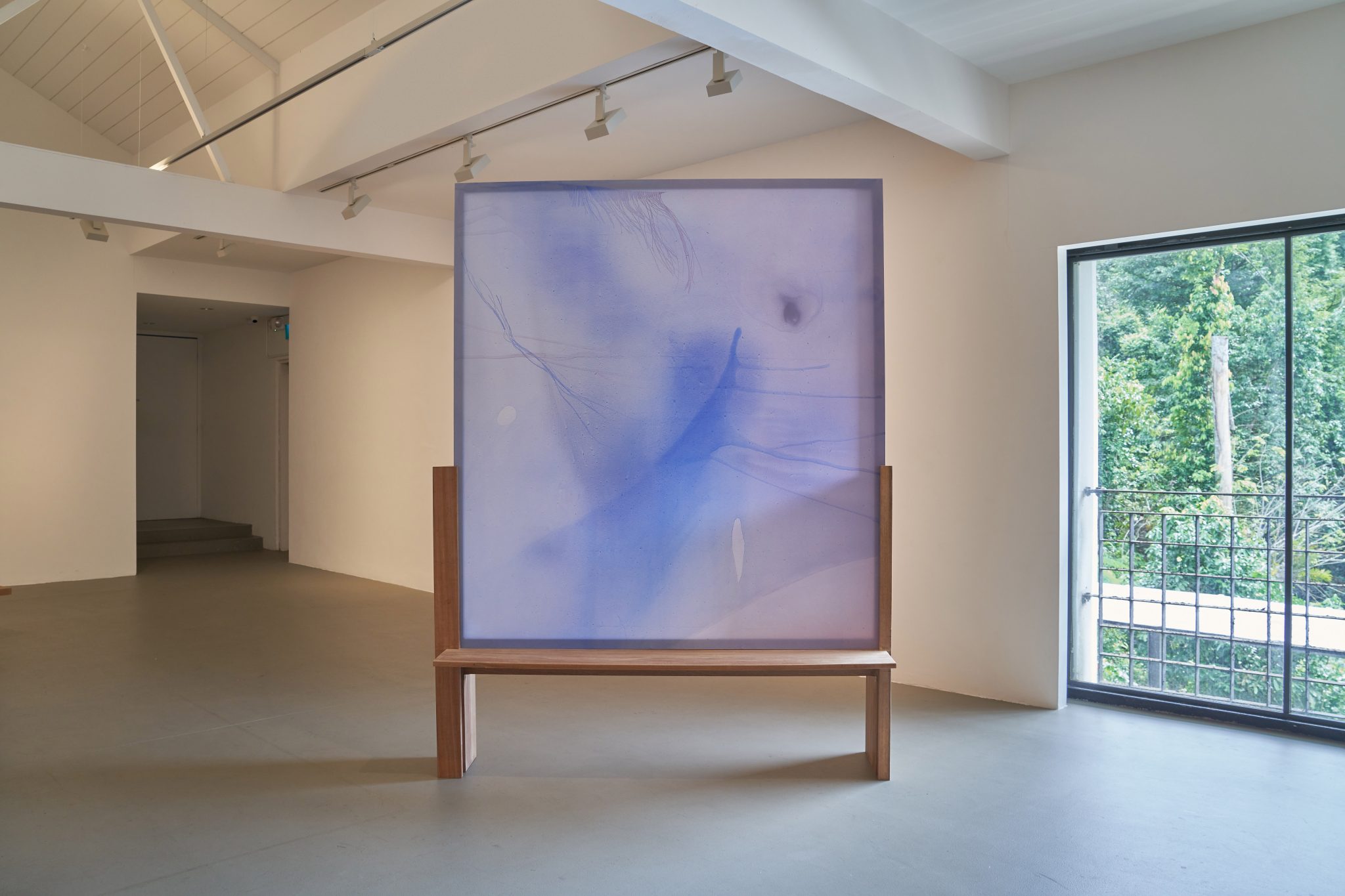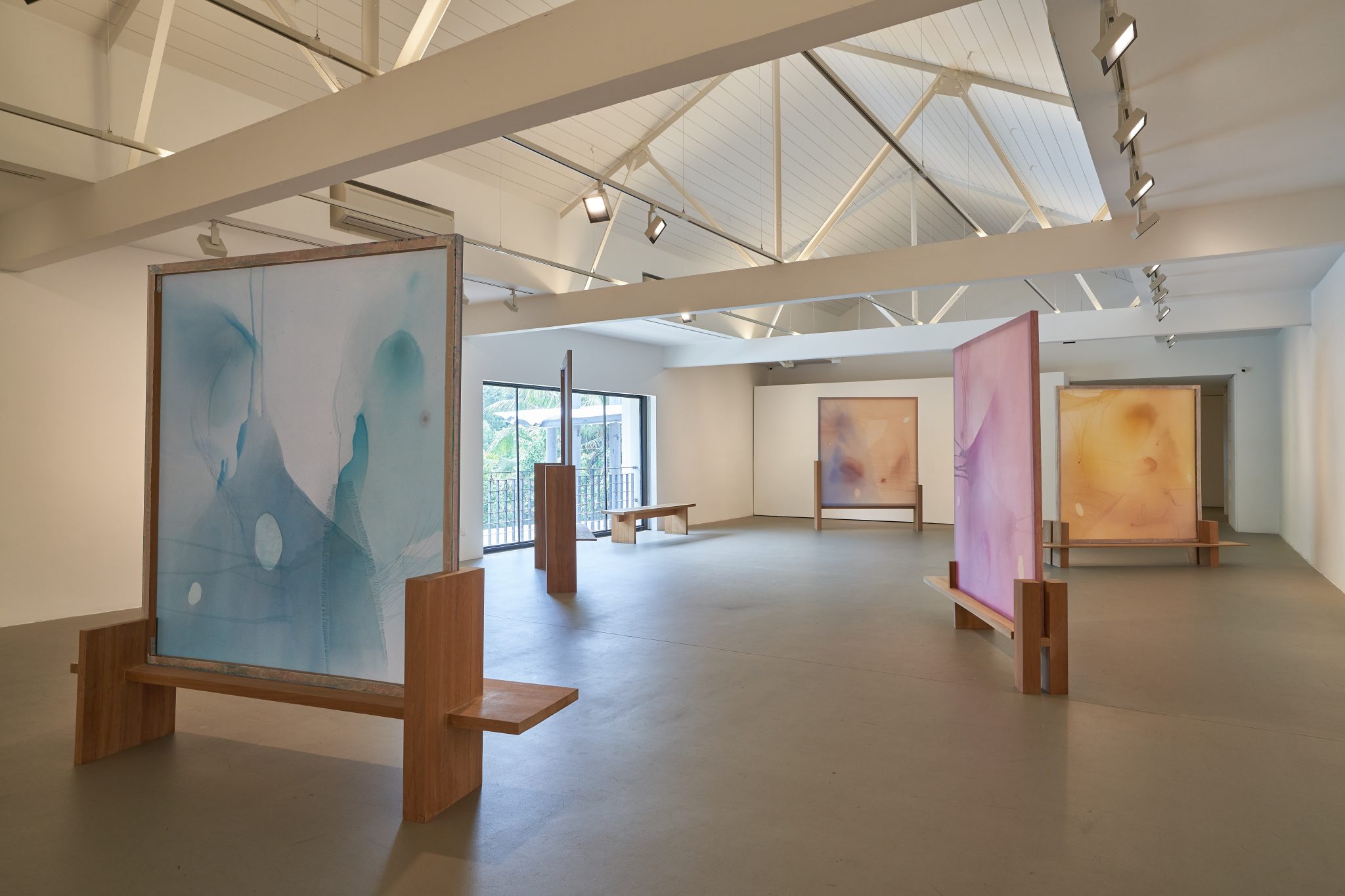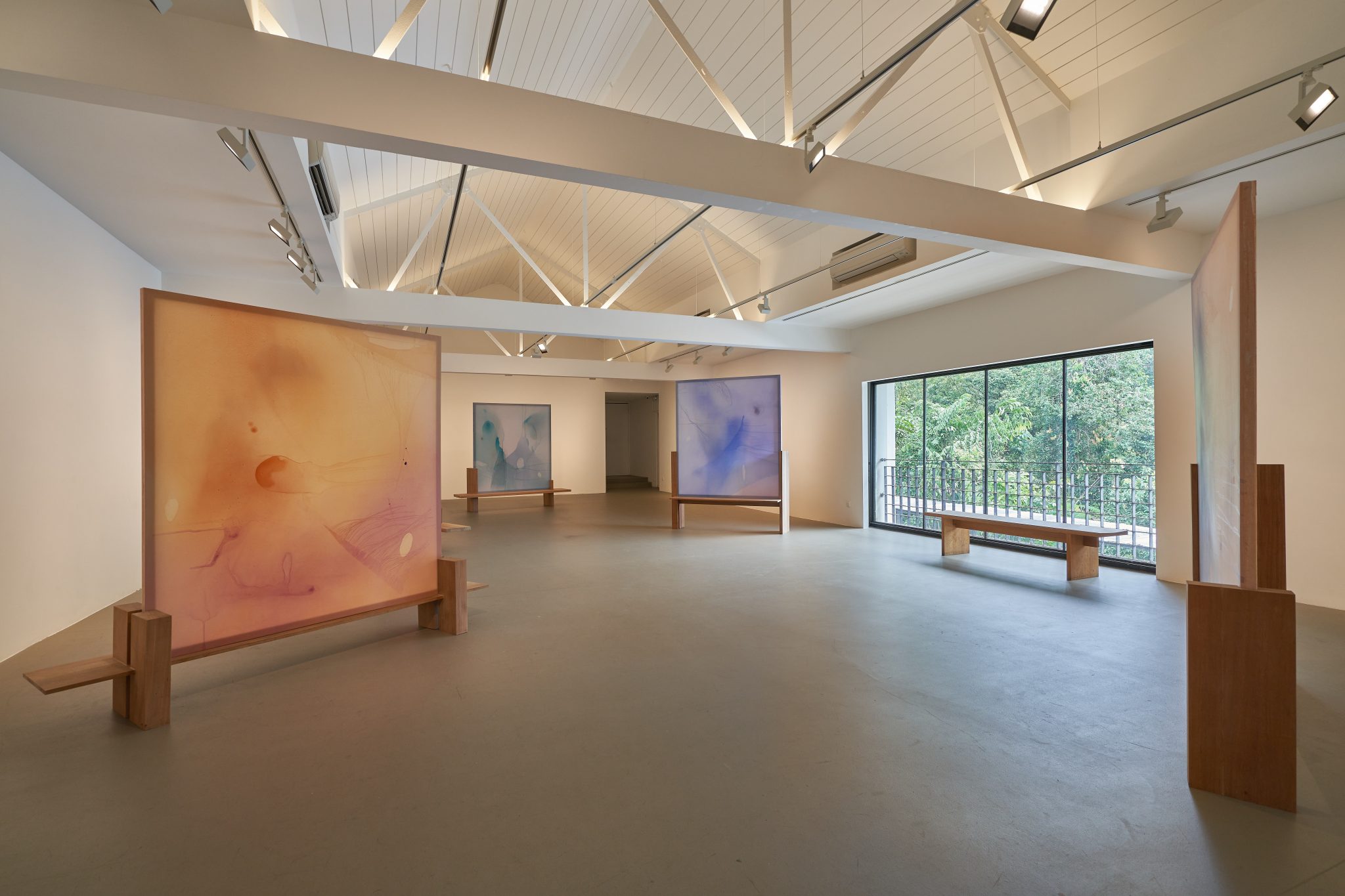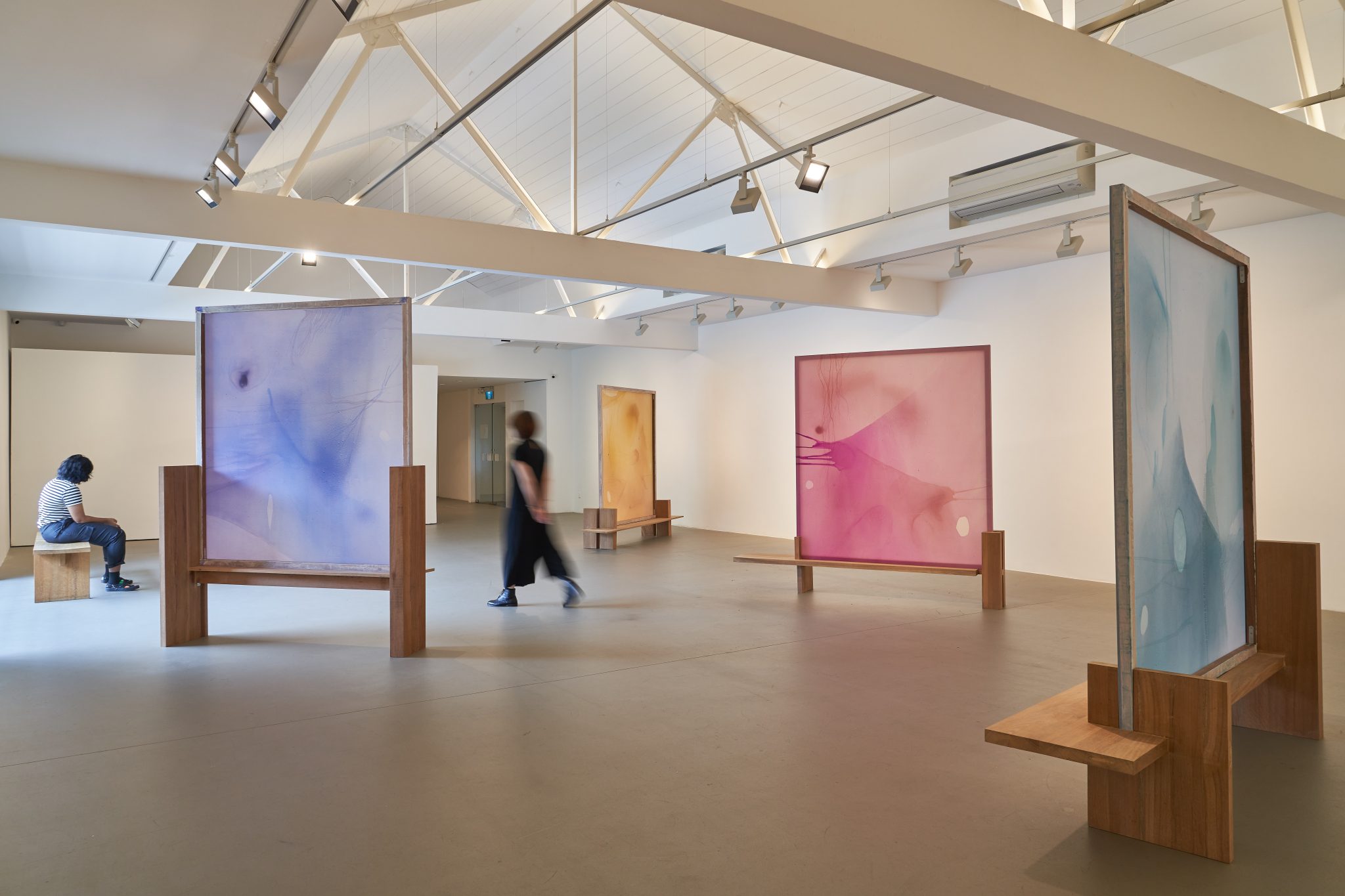
It is tempting to begin an essay on Guo-Liang Tan’s work by referring to histories of painting — in light of the generative ground already laid by other authors, and the fact of his work consisting of paint, cloth and wooden support.1 That said, even as the artist regularly applies liquid pigment to cloth, sometimes during the same year, month or day, Tan is also to be found curating group exhibitions featuring work by peers and predecessors that often mix the time-based media of photography, video and film, with the fine arts of painting and sculpture.2 Indeed, when looking across the artist’s production, painting and the moving image have long been parallel pursuits in Tan’s life for the past fifteen years, if not more. And so I want to suggest that his new work in Soft Turnings offers us another way into his work, one neither located in the space of painting nor the realm of cinema, but in the dynamic between the two, as they are presently constituted in contemporary art. Since the sixties, painting has already migrated into an expanded field beyond the stretcher, just as cinema has been dispersed across multiple channels and screens, as expanded cinema and video installation.3
And so Tan’s current body of works follows in the wake of these developments, particularly with its presentation of painting’s surface (recto) and reverse sides (verso) as though now a standing projection screen akin to multi-channel video installation. This shift has been gradually achieved: similar works began on the wall (for instance in the 2017 Ghost Screen exhibition) before subsequent ones would lean gently against it in the 2020-2021 exhibition Strange Forms of Life, appearing as though Kim Lim’s ladders hold a pictorial relationship to the wall while stepping into the three-dimensional sculptural space of a viewer.
Now that these works appear in the round of the gallery, light not only bounces off their cobalt, magenta, orange and golden surfaces, but passes through their gauzy layers of pooled paint, illuminating both sides for view. More opaque colours might reflect light on the recto side, but conceal on the verso, while translucency on one surface allows more colours to radiate through, when reversed — the colours themselves look different to the eye. One side might be a field of magenta, pink and lavender, while the other side appears crimson, orange and peach. What constitutes a base on one side, becomes a surface on the other, and due to the composite character of the paint, its sedimentation and separation, even though each side shows the same paint and composition, their recto and verso are discernibly different in hue, saturation, intensity and form. And so colour is no longer a question of pigment but perhaps more importantly given by weight, density, opacity, and translucency of chemical interactions.


When presented in space, these works take on the look of a permeable, dual-sided or 360-degree screen. Spectators not only behold an image as a discrete work, but pass between them as though they are a series of decorative screens and a sequence of moving images. And so the works not only rethink painting’s relationship to its support, or the relationship between painting and sculpture, they also deconstruct what film critics across the twentieth century have called the apparatus, or the interrelation of camera, projection, movement and screen, and the ways these form a techno-sensorial unity laden with ideology.4
If the front of a painting is where we experience a picture and its transcendence of space and time, a painting’s typically unseen back is where acknowledgements of its status as a thing and commodity take place — bills of sale or identification, stamps of passage and marks of travel, straps for holding and hanging are often affixed here, along with remnants of a painting process that bled through or dripped past a surface. Precedents for this approach exist: for instance, Lina Bo Bardi’s 1968 display at the Museu de Arte de São Paulo, in which paintings were suspended on easels of glass, vertically anchored by a base of concrete block. Viewed in an open-plan arrangement through which painting appears within a public field of other objects and visitors, this formed a decisive departure from the kind of modernist hangs pioneered by curators such as Alfred Barr, more typically used in painting’s display, in which paintings are widely spaced and hung at eye level with near-invisible display attachments that establish them as autonomous objects for sovereign, singular viewers, and also for an art market’s commodification.
From their inception, Tan intended the reverse sides of these works to be seen. In producing these works, the artist regularly flipped the works over, between sessions of pouring paint, to inspect how the paint developed and incorporated this information into his subsequent actions upon a frontal surface. Tan notably also produced custom structures for the presentation of these paintings. Holding structures consisting of wooden planks support the base and lower sides of each work and hold them upright, allowing their recto/verso views. The forms of these structures evoke benches and shelves, an open frame and large easel — which is to say their presentation links both the finished work to the contingency of its preparation, display and furniture, the object of art and the accoutrement of objet d’art. These structures were custom built with individual designs for each; the width and height of their construction varies, while all the paintings are the same size. Tan does not pair any painting to a specific structure, rather, these were conceived separately and may be reshuffled in a kind of aleatory, random order reminiscent of the American neo-avant-garde, in which John Cage’s music, Robert Rauschenberg’s combine structures and Merce Cunningham’s dance choreography were separately conceived, and only integrated upon their live performance, to surprising effects.
To date, there is no set schema for the placement of Tan’s paintings in a gallery. And so their presentation is site-responsive, things that a viewer moves amongst, perambulates around, to feel light, space and time unfold around them — an exhibition strategy far more apropos that of multi-channel artists’ film or minimalist sculpture. It bears mentioning that curators of artist’s moving-image works often have more options and variables for a work’s display. A painting curator might work with height and juxtaposition, but a film and video curator explores different versions of equipment, monitor and projection considerations.
Fundamental to these differences between hanging painting and screening film or video, are the distinctions between an original masterpiece and a reproducible work. Having personally hung museums’ prized paintings that could only be moved twice — crate to cradle, cradle to wall — with attachments that permitted just a few parts of the painting to even be touched in order to limit handling and damage, one becomes aware of how the logic of the original and masterpiece is produced through the logistical, installation and insurance requirements of the curatorial process. On the contrary: curators of reproducible moving-image work often have versions and ranges to work with, DVDs can be sent in the mail or a digital drop rather than via dedicated and guarded trucks. And while never completely open-ended, their variations are more commonplace. An artist’s film might require a set aspect ratio and projection size, but it might also be presentable in a mixed or discrete setting, black box or white cube, with an option for monitors of various sizes and a range of plinth heights.
As a curator who has shown multiple mediums, and sometimes moving-image work, Tan has built in options for his paintings: their support structures are variable, devised separately as a series of five (for now), affording a finite number of variables and random order by which they are paired with paintings. If we looked at these works in the tradition of the graphic arts, we might understand them as series — one after another — but via the logic of cinema and video, we might consider them as versions of a project and variations on a theme, because presenting film is rarely a penultimate endeavour when moving-image makers show works in progress, different cuts, with new restorations and transfers. Not only do moving-image works exist in multiples, their versions are viewed over time in public. And so I wager that Tan’s 2021 works draw upon the presentational logic of screening, even as their materiality conjures the sense of a screen.
Screens for the projection of motion pictures are typically produced with durability in mind: they should be resistant to tearing, tightly woven, and disperse light evenly. The aeronautical fabric that Tan has favoured for his recent works happens to possess similar properties. The fabric is light in weight and luminous to the eye, with a strong, tight weave that holds the undercoat of medium and layers of poured paint just enough to prevent its leaking while permeable enough to show their colour and shadow. Tan stretches this fabric taut across a wooden frame, the resulting surface horizontally perched on legs, as though a worktable. Paint is poured onto a pre-selected, pre-treated section of the painting, and a tub set on the ground at the corners. Sometimes a cup props up a corner. Reaching across one side of the painting to grasp the corners, Tan begins lifting, tilting, angling the stretcher, sending eddies of paint this way and that. The paint pools, then seeps in, creating more saturated colour in one place, before another adjustment by Tan sends it streaming across the surface again, clinging to the fabric by design and by accident.
At the start of each pour session, the artist’s movements are broad, more emphatic, but as the paint dries, each adjustment addresses a smaller area, as the range of options reduces. The time of painting is dictated by physics: the velocity and density of liquid pigment and the time it takes to adhere produce the painting, calling to mind postminimal process art whose thrown lead and scatter pieces were anti-compositional and riven with chance. Tan quite literally watches paint dry, as much as he moves it about. Time is spent waiting and observing: the painting is not an event or a field of action per abstraction expressionism, but rather, in Tan’s words, “a situation to be managed” and full of mundane work of monitoring, tweaking, even putting a hair dryer to work to speed things along.
The artist is inside and outside the work, as though a director commandeering the action before watching a recording. All the while, excess paint drips into a tub perched on the floor. Some of the inadvertent mixing of colours is repurposed in subsequent pour sessions. Over time, the sections blend together less by brushstrokes and more by the paint’s pooling, mixing, superimposition and recycling — these produce gradients across colour spectrums with light speckles, their hues and texture calling to mind the effect of camera gels and Instagram filters. The palette work of mixing and testing colours, along with acts of wiping and cleaning up the surface, both occur upon the space of the canvas. And so palette work and waste management are not separate or supplemental to Tan’s painting but fundamental to it.5 Given that more than twenty pours are done for every painting, small wonder then that Tan likens the making of these pieces to housework: as the making of painting is akin the repetitive efforts of reproductive labour, as the artist both directs painting and acts as its maintenance crew.
Watching Tan work, I can’t help but think of feminist filmmaking precedents for his practice: artists such as Joan Jonas reaching back into older footage to superimpose it anew into recent works or letting the wind choreographically shake her camera; Agnes Varda leaving off her lens cap to allow accidental footage into the frame. Such modes of making don’t reinvent the wheel each time but rather seek out resources within an artist’s own production and allow the work’s very environment to leave traces, offer collaboration. The humidity and airflow of Tan’s studio, the pull of gravity, the artist’s physical efforts to channel height, depth and speed on the fly and all the specks of dust and grime that arrive on the canvas during these pours — they all exert unpredictable effects, and the challenges to volition are made welcome. This produces an anti-expressive painting, in which detritus is salvaged and the world let in, every smear, and stain and pool a creature of the studio’s atmospheric contamination. Even as the artist surely produces beautiful, diaphanous surfaces, these are also humorously dirty pictures, with all the smudge and seduction the phrase implies.
These current works include swatches of fabric that are not adhered, but used as though prints upon his poured paint surfaces. Tan selects pieces whose edges are deliberately frayed, whose application and trailing ends brings a sense of veiling, movement and dynamism to the works. A key influence for Tan’s surfaces and seriality was Loie Fuller’s famous Serpentine Dance (1896), one of the first dance films, originally performed by an unidentified dancer and filmed by the Lumiere Brothers. According to Stamatia Portanova, Fuller’s dance film consisted of a performer
“manipulating a circle of silk panels worn from the neck: through the rotation of two rods extending from her arms, she was able to create a twisting line of winding fabric, at the same time combining the effect of her moving multicolored veils with those of stage light. Movement was thus staged as a luminous continuity of electromagnetic particles, a flow of polychromatic light perceptually divisible into successive figures: the woman, the flower, the butterfly.” 6
Fuller’s Serpentine Dance and its extravagantly animated veils of colour marked Fuller’s incorporation of newly-available electric modes of stage lighting, whose apparatus that impressed an audience, describing it in “nonprivate, nonnaturalistic, indeed practically impersonal terms.” According to Ann Cooper Albright, “If Duncan is mythologized standing, waiting for divine inspiration, Fuller is pictured with her sleeves rolled up, ready to experiment with the next interesting variation on a theme.”7 For such an enchanting display, Fuller’s was a dance of technical experiment and tests that corresponded with cinema’s development. Stamatia Portanova notes that the effect of fabric, light and movement on film “closely resembles the flowing frames of early cinema, a flow in which no narrative scheme or montage editing yet appears, but only a frenetic succession of stills.”8 If Fuller’s dance film was to be subsequently theorized to be a “choreographic-cinematic apparatus, exposing a light matter that already seems to magnetically attract an infinity of possible cuts and recombinations,” we might think of Tan’s 2021 work as a painterly-cinematic apparatus in which the artist deconstructs the preparation, finish and exhibition of painting, not by staying within it but by incorporating the logic of moving-image flow, preparation and presentation. Put another way, Tan curatorially shows and cinematically directs his painting as part of an apparatus: producing its setting, testing possible arrangements and light, making its props, as though a motion picture or movement between frames for spectators to gaze upon and pass between.9

Our passage between Tan’s paintings is not, however, a reverential affair. There is a sense of contingency and gaiety to the luminous, pastel colours of these paintings. While his methods bear no discernible resemblance to those of his teacher Amy Sillman, I’m reminded that both have oscillated between painting and moving-image work, they have both linked painting to its exhibition display, all the while courting the more luscious, decorative aspects of painted surfaces without fear of summoning frivolity, pleasure and desire.10 Indeed, the artist’s attraction to Fuller’s Serpentine Dance lay not only in its technical revolution but in its winking hint of burlesque and evident whimsy. Even as these canvases are expansive and their ideas ambitious — with Arrive, Arrive (2021) at the National Gallery Singapore, they are among the largest examples of his method within this painting format to date — Tan also approaches their production and painterly traditions with dry humour, luminescence and levity.
The unapologetic contamination of this painting with the decorative and cinematic arts calls into question outmoded — but still lingering — binaries in painting between form/concept, abstraction/figuration and more importantly, those hierarchies that elevate painting above cinema, the fine arts above the decorative arts, the high versus popular or vernacular forms. That said, Tan’s is no postmodern collage or abolition of medium. Instead, I would contend that Tan’s work has more in common with those feminist genealogies of oscillating continuously between painting, sculpture and installation, in works by artists such as Jessica Stockholder, through which pictorial, sculptural and architectural spaces shift promiscuously and continuously.11 Furthermore, I would also wager that Tan’s display and direction might be thought alongside feminist curator Helen Molesworth’s theories of installation that trouble the Oedipal triumphalism of art movements succeeding one another, in which artists overturn their predecessors.
Against this masculinist version of history, Molesworth contends that feminists and women artists often seek out those prior as peers and siblings, as a way of wrestling with occlusions in the art historical canon, by actively seeking relationships between generations.12 In contemplating Tan’s paintings, I am reminded of how early versions of this process appeared amidst work of his contemporaries that he put on display, making clear the companions and affinities of which he is part and that he wishes to foster. In Singapore, art history has not only been made about artists, but frequently by and with them, through the efforts of artists such as Tan and others whose studiowork and curatorial direction have made available our sense of possibility. The galleries they’ve touched — as artists and as curators — are full of peers, predecessors and inspirations, calling into being new publics for their art, and the art of others. One feature of Tan’s new works and their dimensional arrangement, is that visitors may queerly glimpse the bodies of people in front, behind, alongside and adjacent to the paintings, as they look upon their surfaces. Not only will we contemplate Tan’s art, we’ll cruise through it as lookers, watchers and perhaps possibly new collectivities for looking at and looking through colour, in another kind of motion picture.
Dr. Jeannine Tang is Assistant Professor of Modern and Contemporary Art History and Interim Program Director of Visual Studies at The New School. She is an art historian who writes about contemporary art and visual culture, curatorial and exhibition history. Before joining The New School, she taught art and curatorial history between 2010-2019 at the graduate program of the Center for Curatorial Studies, Bard College. She has published widely in such venues as Artforum, Art Journal, GLQ, Journal of Visual Culture, Art India, as well as Theory, Culture & Society, in addition to numerous exhibition catalogues and anthologies.
End Notes
- For previous writing on this body of work, see Anca Rujoiu, “What We Take Away With Us (From a Work of Art)” and Kevin Chua, “The Uncommitted Life” in Guo-Liang Tan: Ghost Screen (Singapore: Ota Fine Arts 2017) exh. cat. unpaginated
- Significant exhibitions curated by Tan include Found & Lost (2009) at Osage Gallery and We Who Saw Signs (2011) at the Institute of Contemporary Arts, Singapore. While some such exhibitions occupy distinct periods of production, in some cases exhibitions are organized during the same years that the artist also works on painting projects. For instance, Tan developed the first of his flower paintings in 2003-2004 (collectively presented in the exhibition Play Dead in 2012); during those years the artist also organized the group exhibition And we took ourselves out of our hands (In search of the Miraculous) (2004) at p-10 featuring photographic, video and text. The earlier paintings that precede this recent collection of works — shown in the exhibition Ghost Screen (2017), Ethereal Machines (2018) and Reformations (2019) — were made while Tan curated several exhibitions bringing together painterly, sculptural, installation, photographic and moving-image abstract work, Side Affects (2019), State of Motion: Rushes of Time (2019-2020) and Strange Forms of Life (2020-2021).
- Here I refer to the Tate and Philadelphia Museum of Art’s framing of contemporary painting as ‘expanded painting’ and writings such as Mark Titmarsh, Expanded Painting: Ontological Aesthetics and the Essence of Colour (London: Bloomsbury, 2017) and Anne Ring Petersen, “Painting spaces”, A. Ring Petersen et al. (eds), Contemporary Painting in Context (Copenhagen: University of Copenhagen, 2010). Furthermore, working between painting and the moving image is hardly a new endeavour: in the U.S. and Europe, structuralist film and expanded cinema by Stan Brakhage, Tony Conrad and others applied paint to the film strip, or used paint as projection surface, incorporating risk and damage in their art; while in Singapore, artists such as Ho Tzu Nyen have produced epic works incorporating painted portraiture and video in projects such as Utama—Every Name in History is I (2003). Tan’s recent works — if not much of his production — is indebted to and in dialogue with both traditions, while in this specific series of works, the screen is accentuated as a surface for the image and architecture of viewership.
- Teresa de Lauretis and Stephen Heath, The Cinematic Apparatus (London: Macmillan Press, 1980)
- The process will repeat multiple times during a session in the studio, and over the course of multiple days or weeks. Sometimes other fabrics with frayed edges are temporarily placed over the ground, to block paint or be part of its application, leaving occlusions, tendrils and patches of their prints behind.
- Stamatia Portanova, Moving Without A Body: Digital Philosophy and Choreographic Thoughts (London and Cambridge, Mass: MIT Press, 2013): 22
- Ann Cooper Albright, Traces of Light: Absence and Presence in the Work of Loïe Fuller (Wesleyan: Wesleyan University Press, 2007): 25 “The Invention of the Serpentine Dance coincided with the discovery of electricity as a method of lighting the stage… Loie Fuller immediately saw the possibilities of the new scientific illumination, and with the aid of a few friends she devised a means by which the effect of vivid sunshine could be obtained through the use of powerful electric lights placed in front of reflectors.”
- Stamatia Portanova, Moving Without A Body: Digital Philosophy and Choreographic Thoughts (London and Cambridge, Mass: MIT Press, 2013): 22
- Stamatia Portanova, Moving Without A Body: Digital Philosophy and Choreographic Thoughts (London and Cambridge, Mass: MIT Press, 2013): 23
- Amy Sillman, “Ab Ex and Disco Balls” in Artforum (Summer 2011)
- Miwon Kwon, “Promiscuity of Space: Some Thoughts on Jessica Stockholder’s Scenographic Compositions” in Grey Room (2005) (18): 52–63.
- Helen Molesworth, “How to Install as a Feminist” in Modern Women: Women Artists at the Museum of Modern Art (New York: Museum of Modern Art, 2010)

